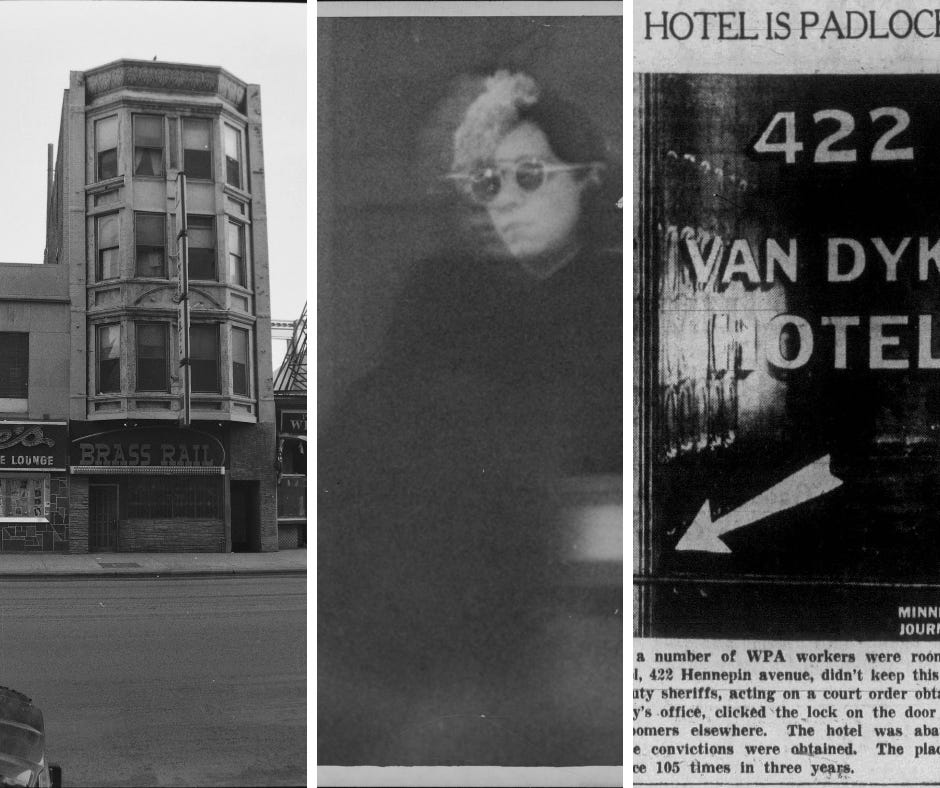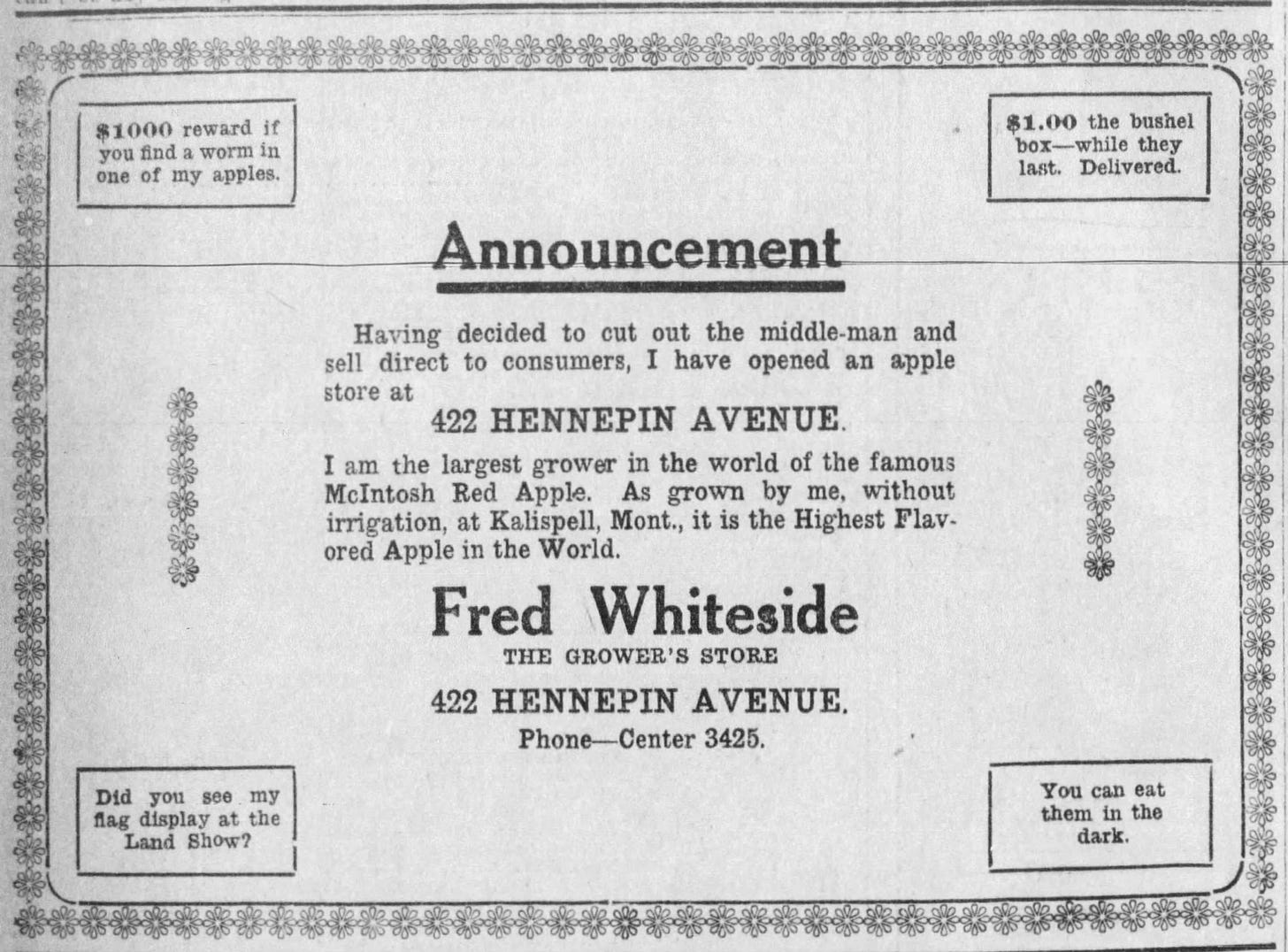The Brass Rail: Forgotten Scandals from Upstairs
Discover 422 Hennepin's wild history of vice, deaths and more.

Not many Minneapolis joints have been around as long as the Brass Rail. Opened in 1930, the Brass Rail’s original location was 414 Hennepin, next to the Palace Theater (414 is a parking lot now). In 1934, the Brass Rail moved to 422 Hennepin, where it’s been ever since. City directories originally listed it as a restaurant, but today it’s a gay bar with a MILF happy hour (go figure). Ask anyone in town, and if they don’t have a story about it (I went there on a date once with a guy who ditched me), they can probably at least tell you where the Brass Rail is.
They probably can’t tell you the stories that lurk behind 422 Hennepin’s blacked-out windows because they probably don’t know that the floors above the Brass Rail were once a good place to get in bad trouble.
Madam Betty Ryan: Courtroom Sensation of 1940
Minneapolis was a hot town. It was 1940, and the Vice Squad was cracking down on bordellos, gambling dens and other “vice resorts.” During the previous decade, Minneapolis had gained a reputation it didn’t like — so many gangsters had come here from other cities to hide out, that people took to calling it “Mobapolis.” By the end of that decade, the city was determined to clean up its act and clear its name, and that meant raiding and shutting down houses of ill fame. It was a bad time to be the proprietress of a brothel — or a cop taking bribes to look the other way.
That year, Minneapolitans were scandalized when Al Palmerston, leader of the morals squad, and his deputy Charles Grunewald were charged with “neglect of duty in connection with the operations of a house of ill fame at 242 Hennepin Avenue.”At the center of it all was Betty “Frenchy” Ryan, proprietress of the notorious house and the state’s star witness at the trial.
According to the Star Tribune’s account of her testimony in court, Betty was born in Boise, Idaho, in 1905. At the age of 10, she traveled with her parents to Frazee, Minnesota, in a covered wagon. There, they lived on a farm, and Betty attended country school until the age of 15. At 19, she moved to Fargo and worked as a head waitress at a hotel. Betty Ryan had several aliases, including Mary Ryan, Betty White, Betty Moore, and Hazel Rice.
In 1929, Betty began running brothels in Minneapolis, which she did “off and on” throughout the 1930s. In 1931, she made her first appearance in the Star Tribune, which reported that she had been indicted for running a brothel at 250 Marquette Avenue, jumped bond, and wound up serving time at the workhouse.
In 1935, she began making payments to high-ranking officials, using Dave Weisman, a liquor dealer, as a go-between. Irene Johnson, Betty’s chauffeur and maid, helped Betty count cash and stuff it into envelopes, which Irene then delivered to Dave Weisman. Payments ranged from $140 to $290 — $3,100 to $6,421 in 2023 dollars.
Betty was indicted again in 1938 after a New Year’s Eve raid on a brothel she was operating at the Van Dyke Hotel at 422 Hennepin Avenue. Vera Moore testified that during the raid, she hid under a davenport while police rounded up the other “inmates.”
“The light flashed on me three times, but they didn’t see me,” Vera testified. “They took the other girls downstairs. I could hear what they were saying, and they said they were going to go over the whole place again. They were looking for Betty and me. They came back and looked around upstairs. A policeman found me. He told me to stay ducked.”
The officer eventually helped Vera escape through a window. When Betty set up shop two blocks away at 242 Hennepin Avenue, the police officer came calling and asked Vera for a “donation” in exchange for helping her go out the window.
The next year, Betty had a falling out with Weisman and began paying Palmerston, Grunewald and others directly.
February 1940 is when it all began to fall apart. On January 11th, police raided and padlocked Betty’s establishment at 242 Hennepin. A girl who had sought work at the brothel and been turned away for having a venereal disease allegedly tipped off the police. It came to light that high-ranking officials knew what was going on at 242 Hennepin and allowed it to continue. Al Palmerston and Charles Grunewald were both indicted for taking bribes.
Also Known As. Betty Ryan had several aliases, including Mary Ryan, Betty White, Betty Moore and Hazel Rice.
Betty was in El Paso in February of 1940 and didn’t know she was wanted in Minneapolis. She returned and pleaded guilty on February 16th, 1940. She was sentenced to serve a year in the workhouse and pay a $1,000 fine. (Adjusted for inflation, that works out to be $22,143 in 2023 dollars.)
Though the inhabitants of the Minneapolis demimonde initially believed that there was “no way” that “Frenchy” would talk, she turned state’s evidence and testified at multiple trials against the powerful men who had taken money from her in exchange for turning a blind eye to the goings-on at her establishments.
Starting in March, Betty and the trials where she testified were featured in the news nearly every day until the end of July. Courtroom testimony featured lurid descriptions of life in a bordello and attracted such large crowds that police officers had to erect barricades in the courtroom to keep the onlookers under control. Betty and Irene had to “run the gauntlet of curious” to get out of the courtroom, slipping out of side doors and ducking photographers’ flashbulbs.
The Star Tribune reporters noted that Irene Johnson spoke in a “quavering voice” when she described the way the “girl inmates” would enter the parlor in their pajamas, “disrobe and stage their dances.” She went on to say that the dances took place “three or four times a day.”
Irene’s testimony also described Betty’s “house of ill fame.” According to the Star Tribune, she “told about the double doors, one at the foot of the stairs and the other at the top, and described their locks.” While the Star Tribune doesn’t go into detail about Irene’s description of the locks, it seems to imply that both sets of doors were locked, an eerie hint that Betty’s brothel was a rough place. Irene went on to say that the second floor had three parlors and five bedrooms, and the third floor was all bedrooms.
The story had everything -- corruption, sex, booze -- and the Star Tribune milked every sensational drop. The paper devoted countless inches of column space to it and printed portions of the court transcripts. In one instance, the paper describes an exchange in which the defense attorney, Harry S. Swenson, asks Per Larson, the prosecutor, “Are you Stalin, Hitler, Mussolini or what?” It ran next to stories about British attacks on Nazi convoys and the fall of Rotterdam.
News stories often described what Betty wore to court. On one occasion, she wore a “dark fur coat, polka-dot trimmed hat with a veil and a blue polka dot dress.” On another, she wore a “form-fitting black dress and a postage stamp hat.”
Betty’s most significant accessory, however, was the pair of sunglasses she wore while testifying. On April 2nd, 1940, the Star Tribune wrote, “After an hour of testimony, Miss Ryan removed her sunglasses, and for the first time the curious audience got a full look at her. She showed no signs of the strange hysteria she was reported to have suffered at the workhouse after her courtroom appearance in the Grunewald case.”
You can almost hear the gasps rising from the gallery when you read that description.
On July 3rd, 1940, the Star Tribune reported that Betty had been released from the workhouse after serving 5 months. The judge granted her leniency thanks to her cooperation in the Grunewald and Weisman trials. She was ordered to leave Minnesota and vowed to make a new life for herself in Alaska.
In September, the paper mentioned her name in connection with additional testimony that she was called on to give, and stated that she was living in Wisconsin. After that, Betty’s trail goes cold.
Booze Raid
August of 1926 would’ve been a bad time to get caught with 11 and a half quarts of “colored moonshine,” but that’s exactly what happened to Stella Sweeney, who was arrested following a raid at 422 Hennepin on August 28. Federal agents raided two other properties that same day, making one other arrest. Alleged bootleggers at the third location managed to escape after pouring their moonshine down the sink.
Gas Poisonings
Two accidental deaths were reported at the Van Dyke Hotel in September of 1920. On September 4, 1920, The Minneapolis Journal reported that J. B. Olson was found unresponsive in his room at the Van Dyke hotel and later died at the General Hospital. In the next day’s issue, the Journal stated that a cattle rancher from Mercer, North Dakota, who’d come to Minneapolis to sell his herd, was found dead at the Van Dyke after falling asleep with the gas jet partially on. The Journal listed his name as S. O. Saby.
Could J.B. Olson and S. O. Saby have been the same man, and this discrepancy is simply the result of a reporter’s screw up? Or did two different men really die at 422 Hennepin within a day of each other? Mistakes and misspellings are common in old newspapers, so it’s likely it was just an error.
On the other hand, 422 Hennepin was built in the 1880s, and by the 1920s, its gaslight system would have had a lot of wear and tear. Perhaps the pipes leaked, or the worn-out valves didn’t close all the way, letting gas escape and killing two men as they slept.
In 1906, a man named Henry Sussman was arrested at 422 Hennepin “just as he was on the verge of being poisoned with illuminating gas,” The Minneapolis Journal reported. Henry Sussman was accused of murdering his wife. I’ll cover this story more in a future post.
Original Vice
Betty Ryan was not the first person to run a “house of ill fame” at 422 Hennepin. A 1916 edition of The Minneapolis Journal reported that Robert Mason had been arrested for “knowingly permitting two young girls and their male escorts to occupy a single room at the hotel one night in January.” The article refers to 422 Hennepin as the Nashville Hotel, a name that seems to date back to about 1899. City directories show it was changed to the Van Dyke Hotel in 1916.
Woman Burned in Gasoline Explosion
Long before the Brass Rail, the Gem Coffee House occupied the lower floors of 422 Hennepin. In August of 1899, a gas stove exploded and severely burned 30-year-old night cook, Christine Lund. News reports said her screams could be heard for blocks.
The Grower’s Store
422 Hennepin has seen more than its fair share of vice, death and destruction, but it’s had wholesome moments, too. In 1912, an apple grower named Fred Whiteside, tired of dealing with middlemen, decided to open an apple store at 422 Hennepin. He promised $1000 to anyone who found a worm in one of his McIntosh apples.





I'd like to know more about Fred Whiteside and his apples! And his note about "You can eat them in the dark" - what does that mean?